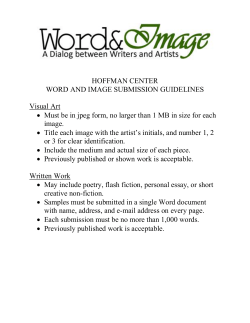
Using Three-Dimensional Graphic Organizers for Classroom
Using Three-Dimensional Graphic Organizers for Classroom Differentiation Kim A. Hardin and Yara N. Farah Increase in Diversity • Diversity must be considered by teachers when preparing and delivering instruction. • Demographic trends in the United States show that the nation’s schools are increasingly populated by students from diverse backgrounds related to differences in: Culture Language Ethnicity and Race Abilities Socioeconomic Status (NCES, 2010). Effective Instructional Practices with Diverse Students • Children come to school with multiple and varied experiences, abilities, learning preferences, interests, and talents (Bruner, 1985; DarlingHammond, 1995) • For this reason, an effective use of instructional practices takes into account individual differences (Tomlinson, 2000). Differentiation • Tomlinson and Allen (2000) define differentiation as “a teacher’s reacting responsively to a learner’s needs” (p. 4). A. Content: the knowledge and skills needed as well as desired by the student B. Rate: the time needed to learn new material C. Environment: the type of setting that enhancing the learning experience D. Preference: the student’s choice of learning resources (Johnsen, Haensly, Ryser, & Ford, 2002) Why Foldables®? • Schema Theory – the general knowledge structure in comprehension; new information must be linked to existing knowledge (Bartlett, 1932; Bransford, 1979; Piaget & Inhelder, 1969) • Zone of Proximal Development and Scaffolding Learning (Vygotsky, 1987; Wood, Bruner, & Ross, 1976) • Engaging students in active learning (Bruner, 1960) • Creating student pride/ownership through generative activities (Peper & Mayer, 1986; Stefanou, Hoffman, & Vielee, 2008) • Note taking aids in the organization and access to knowledge and increased retention (Castello & Monereo, 2005; Einstein, Morris, & Smith, 1985; Kiewra, 1989; Peper & Meyer, 1986; Piolat, Olive, & Kellogg, 2005; Stefanou, Hoffman, & Vielee, 2008) 1- tab, 2-tab, 3-tab, and Multi-tab • The ‘Jack-of-all-Trades’! • Awesome for vocabulary and definitions • Great for linear information! Shutter Fold • Excellent for Projects and Storage • Can be cut into a multi-tab to show cyclical relationships Layered Book • Good for showing and differentiating between levels of information • Great for layering when there is a large volume of information Envelope Fold • Good for when you’re tired of multi-tab and shutter folds • Great for historical figure “Bio’s” Thank you for Coming Today! Feel free to contact us at kim_hardin@baylor.edu yara_farah@baylor.edu References Bartlett, F. C. (1932). Remembering. London: Cambridge University Press. Bransford, J. D. (1979). Human cognition: Learning, understanding and remembering. Belmont, CA: Wadsworth. Bruner, J. S. (1960). The Process of education. Cambridge, Mass.: Harvard University Press. Castello, M., & Monero, C. (2005). Students’ note-taking as a knowledge-construction tool. Educational Studies in Language and Literature, 5, 265-285. Einstein, G. O., Morris, J., & Smith, S. (1985). Note-taking, individual differences, and memory for lecture information. Journal of Educational Psychology, 77(5), 522-532. Peper, R. J., & Mayer, R. E. (1986). Generative effects of note-taking during science lectures. Journal of Educational Psychology, 78(1), 34-38. Piaget, J., & Inhelder, B. (1969). The psychology of the child. Basic Books. Piolat, A., Olive, T, & Kellogg, R. T. (2005). Cognitive effort during note taking. Applied Cognitive Psychology, 19, 291-312. Stefanou, C., Hoffman, L., & Vielee, N. (2008). Note-taking in the college classroom as evidence of generative learning. Learning Environments Research, 11(1), 1-17.
© Copyright 2025









